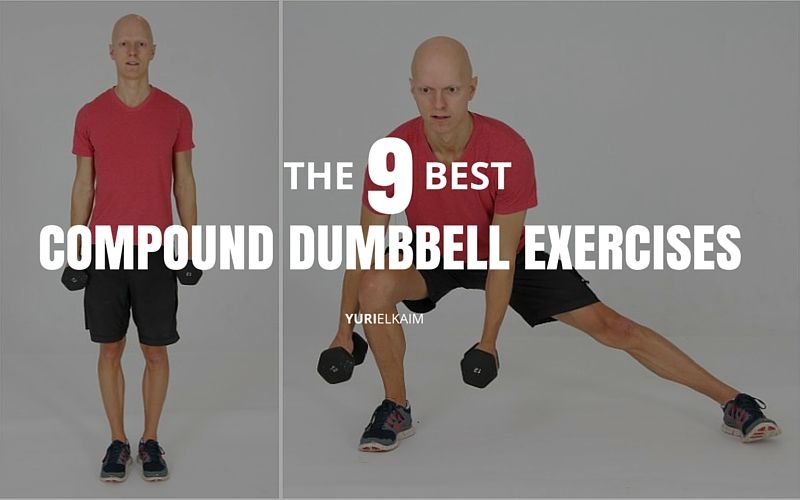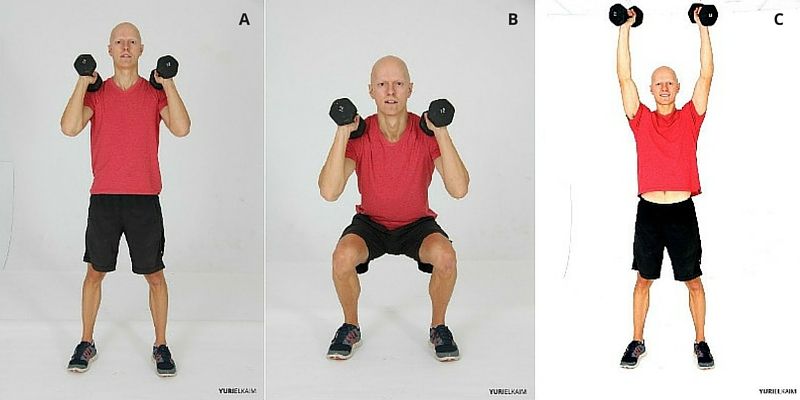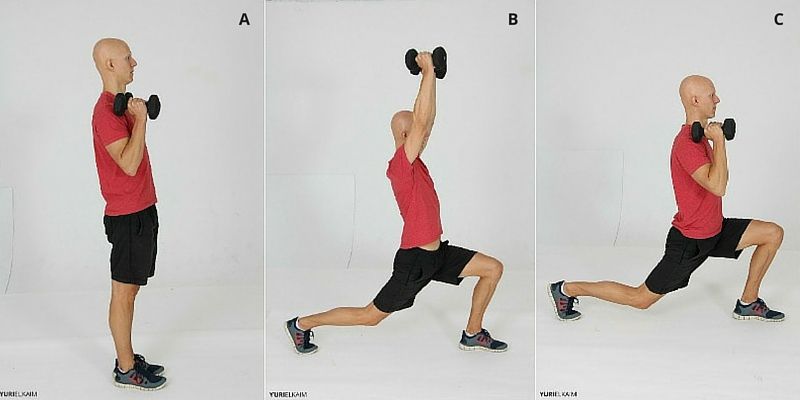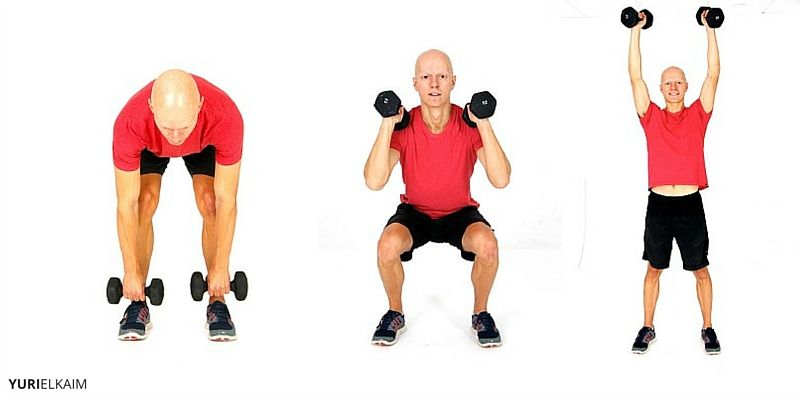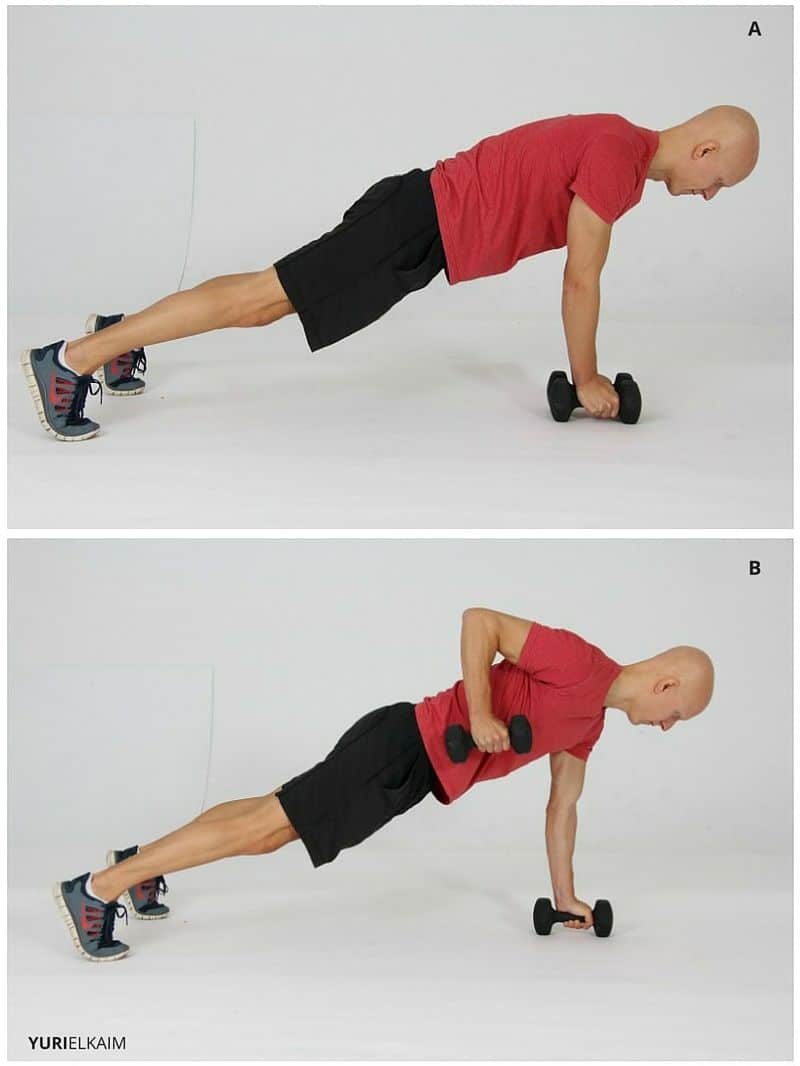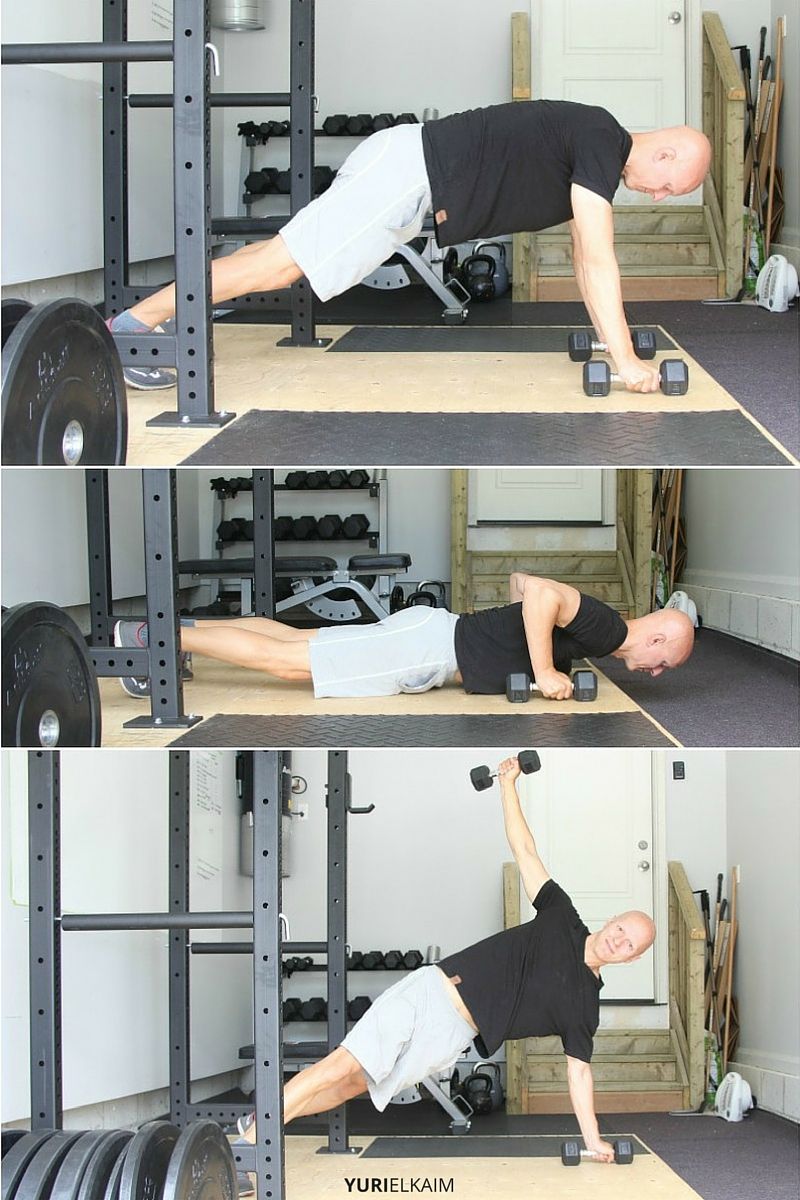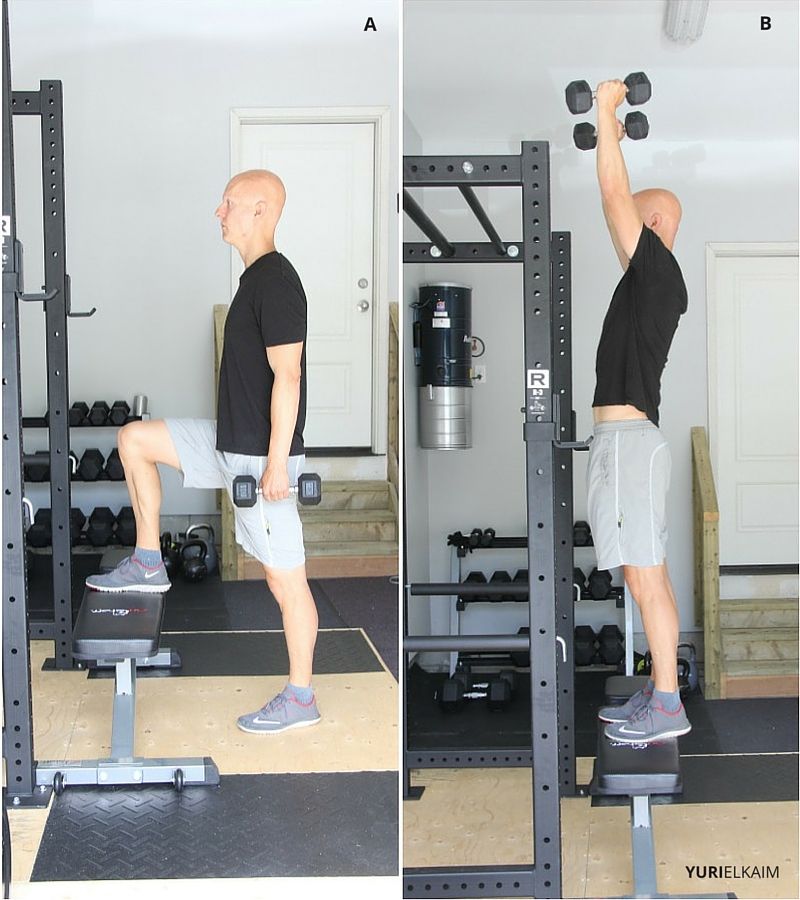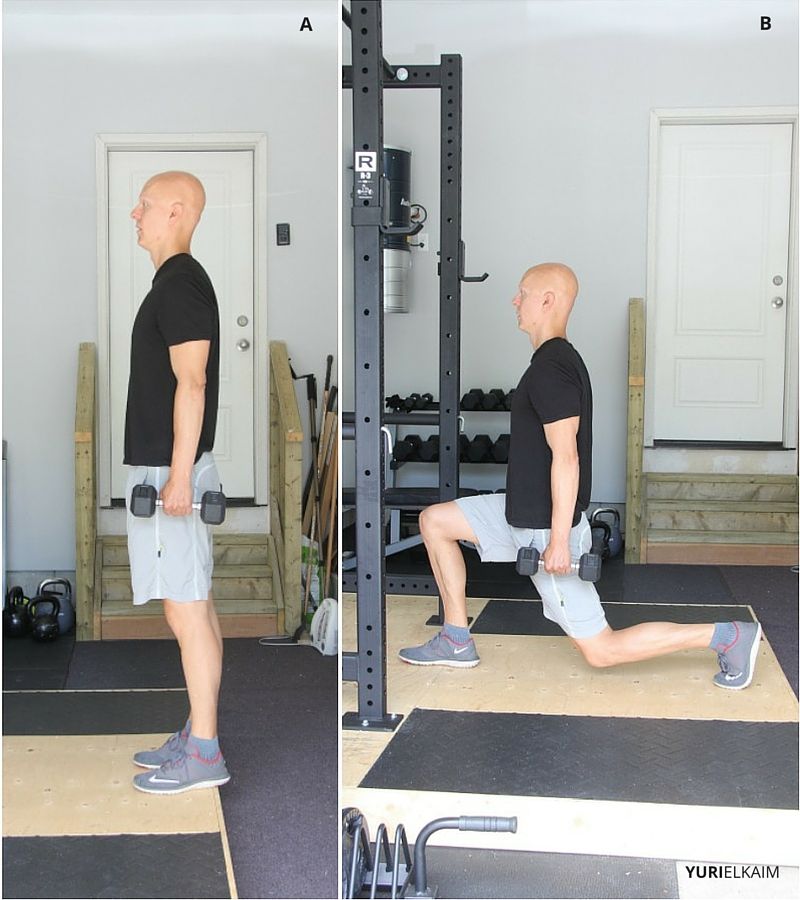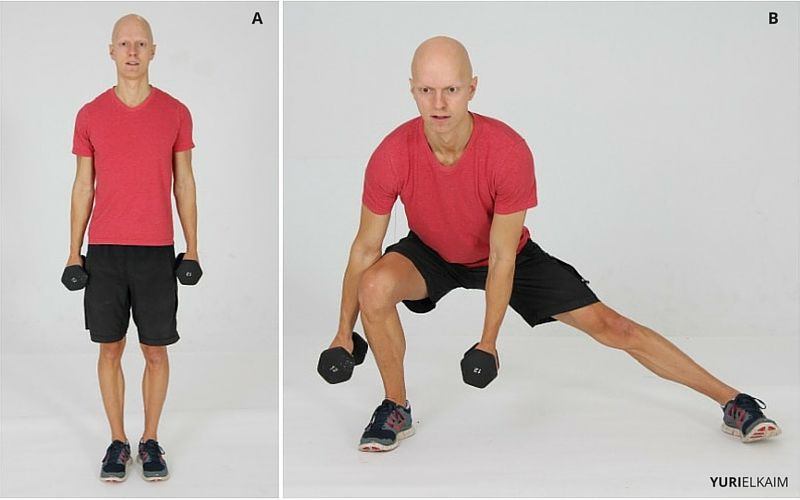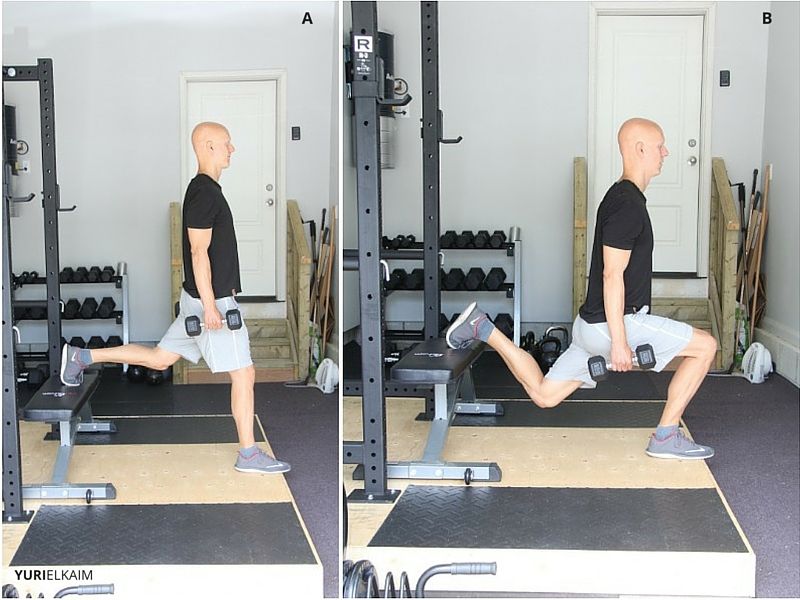Step aside, chronic cardio: compound exercises are making a comeback when it comes to serious (and lasting) fat loss.
In this article
I can already hear the concern.
“But wait – how can we have serious fat loss without cardio? We need to burn calories to lose fat!”
While it’s true that cardio – such as steady-state running on a treadmill – will burn a burst of calories in the short term, that is precisely the point to remember: calories are being burned in the short term.
Is a set calorie burn (and a lot of lost time) truly the best we can hope for when it comes to getting an effective workout?
This is where the awesomeness of compound exercises comes in.
What are compound exercises?
Compound exercises are a type of exercise that engages multiple muscle groups and joints simultaneously, allowing you to work more muscles in less time. When we add dumbbells into the equation, this provides an added challenge to your workout, but also the ability to further customize it based on your strength and goals.
The 9 Best Compound Exercises with Dumbbells
Don’t worry about the lack of equipment, as the workouts listed below require only two heavy dumbbells. Plus, they can be done anywhere, no gym required!
With that being said, let’s get started!
1. Dumbbell Squat Press
The squat press is one of the best compound exercises for fat loss and muscle gain, as you’re working nearly every muscle group in one movement.
Just squatting on its own activates nearly every muscle in the body, from the quadriceps and hamstrings to the glutes and even the back muscles (2).
Adding the press at the peak of your squat further compounds the exercise and recruits the full spectrum of stabilizer muscles in the upper body and core, with a main focus on the triceps and shoulders.
Common Mistakes
Before we get to squat-pressing, it’s important to remember that proper form is crucial when performing compound exercises, as poor form can result in excessive strain on the knee joints, the spine, and the lower back.
Avoid the common mistakes below to get the most out of the squat press:
- Rounding the spine: It’s tempting to round your back or slouch forward during a squat (especially when you’re holding dumbbells at shoulder height). This puts a heavy strain on your spine. Instead, be sure to pull in the stomach (engaging the core) and keep the spine straight by pushing your hips back on the way down.
- Knees going past the toes: Another common mistake is bending the knees out over the toes while squatting, which is a huge no-no, unless you want to risk damaging your knees.
Remedy this mistake by pushing your hips back as if you’re sitting in a chair. Keep your chest open and spine straight.
How to do it:
- To perform the squat press, hold your dumbbells (starting with a comfortable yet challenging weight for beginners) close to the shoulders at shoulder height.
- With your feet slightly wider than hip-width apart, begin to squat, pushing your hips back with your spine straight.
- Once your thighs have reached just below parallel, return to standing and press your dumbbells overhead.
- Return the dumbbells to shoulder height and repeat.
2. Dumbbell Lunge Press
The lunge press is a variation of the basic lunge, which is an outstanding leg exercise targeting the quadriceps and glutes.
The extra weight and movement from the dumbbell press take it up a notch, engaging the stabilizing muscles of the core, shoulders, upper back, and triceps.
Common mistakes
- Lifting onto the toes: When lunging forward (especially when starting to fatigue) many lift up onto their toes while lowering down into the lunge and/or when pushing back up. This can strain the knee joints and throw off your balance. Instead, keep your weight across the entire foot, using your quadriceps and glutes to return to standing.
- Knees going past the toes: Similar to the squat position, you want to make sure your knees stay behind your toes when you lower into a lunge.
How to do it:
- Using a comfortable amount of weight, grab your dumbbell and hold them close to the shoulders.
- With your feet shoulder-width apart and knees slightly bent, take a step forward into a lunge position (remember, knees behind the toes).
- Simultaneously press the weights directly over your shoulders, keeping your spine straight.
- Return the weights to the starting position as your push back to standing.
- Repeat, alternating legs.
3. Dumbbell Clean and Press
Another winner in the world of compound exercises is the dumbbell clean and press.
It not only engages the hamstrings and the upper body but also increases explosive movement and fast-twitch muscle fibers, as you’re moving the dumbbells at a fast pace from the floor to overhead.
Common Mistakes
- Rounding the spine: Since the clean begins in a position similar to the deadlift and progresses into a front squat in the middle, a common problem is rounding the spine through these two movements. Be sure to keep your spine erect with your chest open and head forward to avoid stressing the lower back.
How to do it:
- Begin with feet shoulder-width apart, lowering your dumbbells to the floor by bending at the hips and knees. This is your starting position.
- Begin to thrust upward, bringing the weights to your shoulders as you squat and push up to standing, further thrusting the dumbbells overhead into a press.
- Return to the starting position and repeat.
4. Dumbbell Renegade Row
Renegade rows are fantastic for sculpting the entire core, including the deep inner muscles of the transverse abdominis, along with the back and biceps.
Similar to the clean and press, it requires a lot of explosive power to row your dumbbells while remaining stable.
Common Mistakes
- Swaying side to side or rolling the hips: Since you’re in a plank position and rowing your dumbbells upward, it’s easy to gather momentum by swaying slightly to aid in the row. Avoid this in order to protect the spine and engage the stabilizer muscles.
How to do it:
- Beginning with a lighter weight you can maintain good form by getting into a push-up position, hands on your dumbbells.
- Tighten your core and slowly row one arm up just higher than your torso, keeping your chest parallel to the floor.
- Lower and repeat, alternating arms.
5. Dumbbell T-push-ups
T-push-ups are a challenging, advanced move that will build strong stabilizer muscles in the core, and also work the entire upper body.
How to do it:
- Begin in a standard push-up position, arms with dumbbells directly under the shoulders.
- Lower your chest to the ground, then as you push back up, lift your right hand off the ground, shifting your weight into your left hand.
- Extend your arm toward the ceiling so your body resembles a “T.”
- Return to the push-up position and begin on the other side, keeping your hips lifted the entire time.
Modification:
If you find T-push-ups too difficult, you can always modify them by keeping your knees on the floor (use padding if your knees are sensitive).
6. Dumbbell Step-up Press
The step-up press is great for working the hamstrings, glutes, and deltoids (the round muscle of your shoulder). They will also increase your heart rate, maximizing fat loss as you build.
The press can be performed using two dumbbells or can be modified to a single-arm press. Here, we’ll look at the single-arm, as it engages more core stabilizer muscles throughout the movement by holding weight on one side of the body.
How to do it:
- Holding a dumbbell in your right hand, place your left foot on a 12-inch step box or chair.
- Bring your weight to shoulder height.
- Step up onto the box with your left leg, while at the same time raising your right leg to parallel and pushing your weight overhead.
- Alternate legs and repeat.
7. Walking Dumbbell Lunges
You’ll not only feel the burn in your glutes and quadriceps while performing walking lunges, but you’ll also get an amazing core workout due to the balance and strength required to hold a static weight above your head.
Common Mistakes
- Knees going past the toes: Even though the walking lunge is a moving lunge, the same rules apply: avoiding pushing the knees out over the toes as you lower down, otherwise you risk straining the knee joints.
How to do it:
Note that holding the dumbbells above your head (or just holding one with both hands) requires a good deal of balance. If you become too out of breath or can’t maintain good form, try holding lighter dumbbells by your sides during the lunges.
- Begin by standing with your spine straight, holding a dumbbell with a challenging weight above your head.
- Extend your right leg in front of you and lower to a lunge, keeping your knee behind the toes and maintaining you balance. Push up to standing and lunge forward on the left leg.
- Repeat, alternating legs.
8. Lateral Dumbbell Lunges
Lateral dumbbell lunges are excellent for developing the calves, glutes, and hamstrings, as well as the abdominals and inner thigh region.
Common Mistakes
- Knees over the toes: While it might sound repetitive at this point, it is crucial, just as with any other lunge, that your knees remain behind your toes to avoid knee injuries.
How to do it:
- Begin by standing with feet hip-width apart, dumbbells at your sides.
- Making sure to point your knee in the same direction as your foot, take a large step to the right, keeping the dumbbells at your sides.
- Push back and lower your hips until your thighs are parallel to the floor, keeping your knees behind your toes and your spine straight.
- Return to your starting position using your glutes and hamstrings.
- Repeat, alternating sides.
9. Bulgarian Dumbbell Lunge
The Bulgarian dumbbell lunge, also referred to as a split-squat, differs from a regular lunge in that tension remains in one leg while performing reps, instead of alternating legs.
While the Bulgarian lunge is excellent for working the entire lower body, it is also great for correcting weaknesses (say, if one of your legs were stronger than the other) as each leg is working singularly.
The Bulgarian lunge also requires a great deal of balance, as one foot is propped on a bench behind you. This strengthens the smaller stabilizer muscles in the core as well as the legs.
Common Mistakes
- Leaning forward or slouching: It may be tempting to lean forward during the lunge, as your foot is propped behind you. Resist this and keep your spine straight to avoid putting too much strain on the spine.
Knees past the toes.
You know the drill. Be sure to keep the knees behind the toes when lowering into the lunge to avoid excessive tension on the knees.
How to do it:
- Holding a dumbbell in each hand, place yourself in a staggered stance (one foot forward) with one foot propped behind you on a bench or box.
- Descend by bending your knee, keeping your spine straight, and lower until your thigh is parallel to the ground.
- Push through the heel to return to the starting position and repeat.
What are the benefits of compound dumbbell exercises?
Compound dumbbell exercises are classified as exercises that stimulate all of your major muscle groups, which leads to an increased metabolic output (i.e., increased fat burning) for several hours after your workout.
In fact, a study published in the European Journal of Applied Physiology discovered that a 30-minute compound-exercise workout elevated participants’ metabolisms for an astounding 48 hours following the workout – a marked increase over longer, steady-state cardio workouts (1).
This is huge in terms of fat loss, considering your resting metabolic rate accounts for roughly 70 percent of the calories you burn each day.
By adding in the compound dumbbell exercises above, you’ll increase your metabolic rate, build more muscle (which further increases your metabolic output), and blast major calories during the movements.
That beats spending hours each week on a treadmill, doesn’t it?
And not only that, but these compound movements are also functional exercises, which means they get your whole body strong fast.
As a general fat loss prescription, aim for:
- 6-8 repetitions
- 2-3 sets
- Little to no rest between sets
- Working out 2-3 times per week on non-consecutive days
Frequently asked questions (FAQs)
No, performing compound dumbbell exercises every day is generally not recommended as your muscles need time to recover and grow stronger. Overtraining can lead to injuries and hinder your progress. For most people, performing compound exercises 2-4 times a week is enough to see improvements while still allowing for adequate recovery.
Both compound and isolation exercises have their benefits. Compound exercises are great for beginners because they work multiple muscles at once and help build functional strength. They also allow you to get a full-body workout in a shorter amount of time. Isolation exercises target a single muscle group and are often used to correct muscle imbalances or rehabilitate after injuries. As a beginner, it’s beneficial to start with compound movements and gradually incorporate isolation exercises into your routine.
For a well-rounded workout, you might aim to include 3-5 compound exercises that target different muscle groups. For instance, you could choose one exercise each for your lower body (like a squat or lunge), upper body push (like a bench press or overhead press), upper body pull (like a row or pull-up), and a core exercise (like a plank or Russian twist).
Fast, Effective Compound Exercises with Dumbbells
One of the great things about all of these exercises is that you can put together a fast, effective workout really easily by stringing them together.
I’m guessing you’ll be feeling the burn not only during the workout but probably the next day, too.
Want to Burn More Fat?
Check out my new strength and interval cardio combo workout. It’s fun and will definitely ramp up your fat burning.
This Fat Blaster workout includes an instructional video, workout tracker, and follow-along audio. It’s a $29 value – and it’s yours for FREE!
Simply click the banner now to download the workout.


